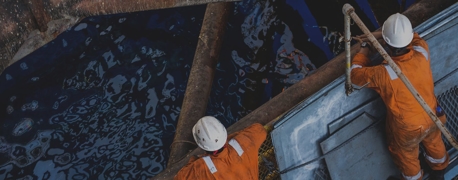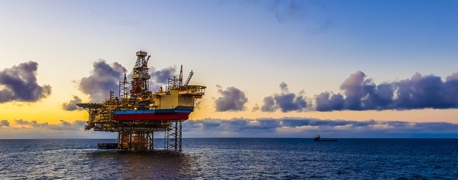10 Oil Rig Phrases & What They Mean

Everyone working on board an oil rig understands how complicated it can be. Even on a clear day, an offshore oil rig requires the attentive work and care of experienced professionals to keep the rig operating safely and efficiently. When a storm is on the horizon, however, the oil company must prioritize its workers as well as the careful shutdown of the rig. When they don’t, people get hurt, property is damaged, and marine life is put at risk.
In this blog, we will explore several phrases you may hear on board an offshore oil rig.
Staying Latched or Unlatching During a Storm
In 2020, the Transocean Deepwater Asgard didn’t have time to disconnect from the well before Hurricane Zeta hit, leaving the ship connected with the riser pipe at a dangerous angle. The emergency disconnect button was hit, but as the ship was blown into shallower waters, the lower marine riser package (LMRP) crashed into the sea bed. Although several other rigs were in the path of the storm, the Deepwater Asgard was the only one forced to stay latched as the hurricane approached.
Emergency Disconnect Package
Should an oil rig unexpectedly move, or need to move quickly such as in the event of a storm, an emergency disconnect package (EDP) is typically used. This equipment package is an important part of the LMRP, providing the ability to disconnect the riser from the subsea equipment quickly. As is indicated in its name, this package is infrequently used; it was necessary on the Deepwater Asgard in 2020 because Transocean stubbornly created an emergency by failing to take basic evasive action ahead of Hurricane Zeta.
Pulling Up the Riser/LMRP
A marine riser is a vertical pipeline used in offshore drilling; these structures are a key part of the operation of an oil well and must be maintained under tension and kept within eight degrees of vertical.
Pulling up the riser and LMRP is a delicate operation even in calm waters, thanks to the unpredictability of ocean currents. But in a situation that requires an emergency disconnect, such as being in the path of a hurricane, pulling up the riser can be even more difficult and dangerous.
Much of the damage that the Deepwater Asgard suffered was to its LMRP–the package was dragged along the seafloor for 2.5 nautical miles before finally coming to a stop. The risers also smashed against the rig during this movement, throwing personnel and equipment alike across the rig. Despite this, Transocean made every effort to quickly repair the Deepwater Asgard and get it back into an “operational state” and connected to the very same well within two weeks of the hurricane.
Securing the Well
An industry term that refers to an integral part of storm preparation, securing the well means isolating the well in order to safely unlatch the drillship or rig. In response to the Deepwater Horizon oil spill in 2010, the Bureau of Safety and Environmental Enforcement (BSEE) published requirements and best practices outlining that a well must have two barriers to prevent flow. A typical barrier might be made up of a cement plug along with casing.
While there are several ways to achieve good zonal isolation, the choice of components of the barriers used in this process is left up to the engineers; the BSEE acknowledges the importance of good engineering judgment despite its other specific barrier requirements.
Red Part of the Cone
When referring to a hurricane, the cone, also called the cone of uncertainty, represents the potential path of the center of a tropical storm. NOAA’s historical data over the past five years have shown that a hurricane can be expected to remain within this cone about 60-70% of the time.
The expected severity of the storm is noted with the color:
- Red: Hurricane warning
- Pink: Hurricane watch
- Blue: Tropical storm warning
- Yellow: Tropical storm watch
Even more data can be taken from the letters inside the dots that track the path of the storm:
- D: Tropical depression
- S: Tropical storm
- H: Hurricane
- M: Major Hurricane
Should an oil rig find itself in the path of a hurricane, especially in the red part of the cone, evacuation procedures must be considered–which, when done correctly and safely, often take days.
That’s what happened in 2020 when the Transocean Deepwater Asgard found itself in the red part of the cone for Hurricane Zeta. The worst-case scenario was that the oil well was capable of spilling 313,000 barrels of oil per day for 99 days, making the potential damage an order of magnitude worse than what occurred in the Deepwater Horizon explosion in 2010. Fortunately, this time, the emergency disconnect system did not fail, but the ship sustained over $5 million in damage and the crew was left in deadly peril for hours.
T-Time
Recent oil rig disasters caused by reaction time–or lack thereof–to severe storms, namely the Deepwater Asgard disaster, have spurred the BSEE to establish new rules for rig owners during hurricane season. “T-Time,” or the time needed to evacuate an offshore oil rig before a storm, must be reported to the agency. Regular updates regarding the progress of oil well shut-ins, removing heavy equipment from the sea floor, and evacuating the crew must also be sent. Because Transocean did not optimize the Deepwater Asgard’s T-Time, the rig and its crew suffered severe damage.
Vessel Heaving
When an oil rig prepares to brace for a storm, there are several possibilities that it must plan for. In stormy weather, the rig will be subject to turbulent seas which can cause the platform to heave up and down, causing an unstable environment for sensitive equipment.
An offshore drilling platform requires a piece of equipment called a heave compensation device known as a drill string heave motion compensator or drilling string compensator (DSC).
Spudding in the Well
Put simply, spudding refers to breaking ground on a well. Spudding in the well refers to beginning operations by drilling with the main bit and drilling to the total depth. During this process, the drill string is assembled and lowered; spudding can take anywhere from two to four weeks for a modern shale well or three to four months for an offshore well.
Squeeze Cement Job
Squeeze cementing requires careful work and involves injecting cement slurry into a zone, usually to isolate pressure. Sometimes, the pressure is widespread in the line enough to require a squeeze cement job throughout the entire casing string, in what is called a bradenhead squeeze.
Ballooning
While drilling a well, workers on an oil rig or drillship may encounter a phenomenon called “ballooning,” which occurs when mud, which is used to offset varying pressure, goes into the formation near the well. Ballooning is common in deepwater drilling, and the team aboard the Deepwater Asgard encountered it while drilling at the Highgarden well just a few days ahead of Hurricane Zeta. This detrimental side effect of drilling can not only cause structural problems in the well, but it can also lead to costly well control procedures.
Running the Storm Packer (RTTS)
A storm packer, or retrievable test treat squeeze (RTTS), is a tool used when regular drilling operations are interrupted by a storm. The storm packer must be run to depth to isolate the wellbore when drilling activities must be suspended, especially in response to an oncoming storm. Because the unit is retrievable, it may be used as a temporary plug during a storm, allowing operations to continue when the weather conditions have improved.


